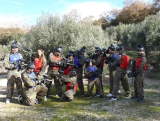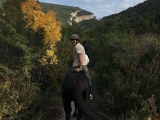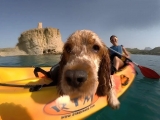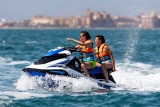A merchant ship repurposed to defend the colonies of the Indies
With the conquest and organisation of the Philippine Islands by Miguel López de Legazpi, the history of Spain's colonial empire in the East Indies and its transoceanic trade began. The port of Manila became the commercial transit hub between China and Mexico after the first two galleons crossed the Pacific in 1573, laden with exotic goods from the East.
The San Diego galleon was a merchant ship likely tasked with commercial missions in the region when, two days before the death of King Philip II, the Dutchman Oliver Van Noort set sail from Rotterdam on 12 August 1598 with a squadron of four ships. After a voyage fraught with difficulties, he reached the Philippines on 16 October 1600. Meanwhile, hostilities between Spain and England, supported by the Netherlands, continued.

The Battle of Fortune Island
The San Diego galleon and the patache San Bartolomé, both under the command of Antonio de Morga, president of the Manila Audiencia and lieutenant general of the governor, were hastily armed and equipped in the port of Cavite (Luzón Island) (the former was fitted with ten cannons and a crew of four hundred Spaniards, Filipinos, and Japanese). They set sail on 12 December to confront the enemy, whom they encountered two days later near Fortune Island. Noort also had two ships: the Mauritius, a 270-ton flagship, and the Eendracht, a fifty-ton vessel.
The San Diego boarded the Dutch flagship in a desperate manoeuvre, despite having suffered a cannonball hit at the waterline. The crew managed to jump onto the enemy ship's deck, and just as the Spaniards had seized the Dutch flag, the enemy vessel caught fire. Antonio de Morga ordered the lines to be cut to separate the ships, believing the Dutch ship would be consumed by flames. However, the San Diego, severely damaged, sank irretrievably, taking 150 men with it. The Mauritius managed to extinguish the fire on board and, still afloat, fled.
The Eendracht was captured by the San Bartolomé, which had pursued it and was unable to assist the San Diego. Its captain was later captured and executed in Manila.
The technical specifications of the San Diego galleon
The exact origin of this galleon is unknown, but it can be confirmed that it was a large cargo ship, judging by the only verifiable data obtained from the hull remains: the 23.73-metre length of the keel at its lower part, equivalent to 41.26 cubits. Applying the Spanish shipbuilding rule of "as, dos, tres," adjusted according to García de Palacio's criteria (1587), this results in a ship measuring 35.3 metres in length, 11 metres in beam, and 5.6 metres in depth, giving a tonnage of 645 toneles or a modern equivalent of 893 tons.

The search for the wreck
For over three years, information was sought in the archives of the Indies in Seville, Madrid, Amsterdam, and the Vatican until clues leading to the remains of the San Diego were found.
Finally, in 1991, thanks to diving and after an intensive search of the seabed near Fortune Island, a team led by French underwater researcher and archaeologist Franck Goddio discovered its remains lying at a depth of 52 metres. From January 1992, the scientific excavation of the wreck began, co-financed by the French ELF Foundation and Goddio himself, while the recovery of artefacts was meticulously documented in an exhaustive record by archaeologists from the National Museum of the Philippines, overseen by its director, Father Gabriel Casal. The work continued until 15 April 1993.
The archaeological excavation work
The underwater excavation began by marking the exact location of the San Diego with a large red buoy. The excavation support system included an archaeological research catamaran equipped with nuclear magnetic resonance magnetometers. The ships involved in the recovery were the Kaimiloa, a tugboat with a large rear work platform, the Osam Service, a small 15-metre tugboat, the cargo Lift, and a small two-seater mini-submarine, the Small.

The diving team consisted of personnel from the European Institute of Underwater Archaeology, as well as two leaders and fourteen professional divers. The team also included specialists such as archaeologists, doctors, photographers, cooks, and the crews of the various vessels.
The dives on the San Diego
The first dives were, logically, for reconnaissance, initially revealing a mound 25 metres long, eight metres wide, and three metres high. The San Diego lay scattered on a rise facing west, as two large anchors marked the bow of the ship. In the early days, diving equipment was prepared, and a diving bell was installed to serve as an elevator for the divers.
This system could transport two divers to the surface via two tubes supplying oxygen to control decompression levels. Two compressors fed a large oxygen reserve connected to the tubes, and a decompression chamber was always on standby for emergencies.
The divers were divided into two groups: one using the bell system and the other diving with autonomous equipment. Multiple oxygen lines were installed for autonomous divers to facilitate decompression stops. With a total of eighteen divers available, it was decided they would work in pairs to avoid interrupting the seabed work, which lasted no more than forty minutes.
After the seabed work, divers spent an average of one hour making decompression stops at various levels before surfacing. As Frank Goddio, the excavation director, noted: "The teams moved in a well-coordinated ballet, and on the surface, the two dive leaders meticulously monitored each diver's time underwater and were responsible for ensuring adequate air supply and communication with the seabed."

On the seabed, each diver worked with water extractors, suction devices, and lead-weighted containers of various sizes to store recovered objects. Each container was colour-coded to correspond to a one-square-metre work area—the maximum a diver could excavate in forty minutes. The excavation proceeded almost without incident, except for two divers stung by scorpionfish and harassed by moray eels, which had made their homes in the ancient stoneware and porcelain jars and refused to leave.
The archaeological artefacts found and the expedition's discoveries
The discovery of the San Diego galleon has been of paramount importance from many perspectives: naval, armament, nautical-scientific instruments, and the countless objects found, which bear witness to inter-Asian trade and life on board at the time. Nearly 4,000 archaeological pieces of incalculable value and exclusivity.

In the category of armament, the bronze artillery pieces—sacres, versos, culverins—and Japanese weapons are of great exclusivity, along with two morions and a large quantity of bullets of various calibres, as well as musket and arquebus projectiles. It was known that the ship carried fourteen cannons, listed in a cargo manifest dated 12 July 1601, all of which were recovered from the seabed.
Various nautical instruments were also recovered from the wreck, such as astrolabes and astronomical rings, of incalculable value due to their rarity.
Examples of life onboard objects include candle snuffers, candlesticks, Mexican plates, cups, ewers, Murano glassware, remnants of cutlery, and silver belt buckles. The coins found aboard the San Diego correspond to the currency in circulation at the time—late in the reign of Philip II (1556–1598) and early in that of Philip III (1598–1621)—including examples of eight, four, two, and one reales, mostly minted in Mexico, though some were from Potosí and a few from the Iberian Peninsula.
Most of the cargo consisted of around eight hundred stoneware jars from Southeast Asia, most with a capacity of 350 litres. These containers were used to transport salted goods and vegetables, as well as gunpowder, sulphur, and fresh water reserves.
The discovery of these urns has provided valuable insights into the crew's diet. Alongside these large containers, Spanish earthenware jars shaped like amphorae were also recovered, used not only for olives but also for wine, candied fruit, tar for ship caulking, and, on the Manila-Acapulco route, for transporting valuable cochineal dye.

The blue and white Chinese porcelain from the Song and Ming dynasties, recovered from the San Diego, is the most valuable collection, as it was the primary trade and export item to Europe via the Manila-Acapulco route. Europe would not uncover the secrets of porcelain manufacturing until the 18th century with the discovery of kaolin, which is why all porcelain in the 16th century was imported from China.
The pieces were found in excellent condition and include dishes, plates, bottles, bowls, and boxes—treasured by monarchs of the era, such as Philip II, who was known to collect such items.











